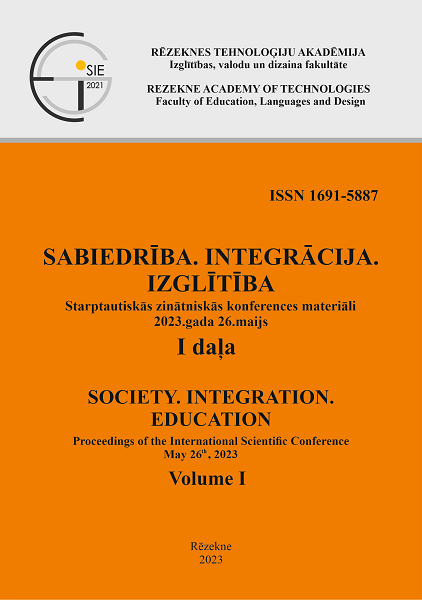APPLYING OF DESIGN THINKING APPROACH IN THE DEVELOPMENT OF FOREIGN LANGUAGE COURSE
DOI:
https://doi.org/10.17770/sie2023vol1.7102Keywords:
acquisition of a second foreign language, communicative competencies, design Thinking approach, legal EnglishAbstract
A lot of people comprehend the necessity to acquire foreign languages and particularly foreign languages for their professional needs, but in most cases, their enthusiasm and motivation decrease and sometimes even disappear when hard work on a regular basis starts. The greatest advantages of the Design Thinking approach in teaching foreign languages are the development of foreign languages’ competencies and the making of the learners more motivated. The aim of the paper is to analyze the development outcomes of communicative competencies by applying the Design Thinking approach to teaching foreign languages to Bachelor level law students who acquire legal English and Bachelor level Information Technology students who study German as a second foreign language. The following methods were used while doing the research: survey data analysis of the foreign languages courses’ target audience and the qualitative analysis of the data content. A questionnaire of the students was developed and carried out, the answers were processed. The research experience was analyzed, the conclusions were drawn and the proposals for future work were worked out. The framework of learning was based on the Stanford method: empathizing, defining the problem, ideating, prototyping, and testing. The results of the study proved that the design thinking approach is effective as the learners solve many real-life problems. This encouraged collaboration and activity as they discussed simulated professional and real-life issues. The results also proved that the design thinking approach is recommended for learners with a higher level of foreign language proficiency. The pros and cons of the approach, based on the learners’ results and questionnaires have been summarized.
References
Brown, H. D. (2007). Teaching by principles, an interactive approach to language pedagogy (3rd ed.). San Francisco: Allyn & Bacon.
Dam, R. F., & Siang, T. Y. (2022). The History of Design Thinking. Retrieved from: https://www.interaction-design.org/literature/article/design-thinking-get-a-quick-overview-of-the-history
Gotlieb, R., Jahner, E., Immordino-Yang, M., & Kaufman, S. (2016). How social-emotional imagination facilitates deep learning and creativity in the classroom. In R. Beghetto & J. Kaufman (Eds.), Nurturing Creativity in the Classroom (2nd ed.), Cambridge University Press, p. 308-336.
Jones, R. (2016). Creativity and language. In R. Jones & J. Richards (Eds.), Creativity in Language Teaching: Perspectives From Research And Practice. London: Routledge, p. 308 - 336.
Lightbown, P., & Spada, N. (2013). How Languages are Learned. Oxford University Press.
Nunan, D. (2014). Syllabus Design. In Celce-Murcia, M., Brinton, D., Snow, A. Teaching English as a Second or Foreign Language (4th ed.). Boston, MA: Heinle ELT, p. 55-65.
Thienen, J. P. A., Clancey, W. J., Corazza, G. E., & Meinel, C. (2018). Theoretical Foundations of Design Thinking. Part I: John E. Arnold’s Creative Thinking Theories. Retrieved from: https://www.inist.org/library/2017-01.vonThienen_etal.TheoreticalfoundationsofDesignThinking_PartI_JEArnolds%20CreativeThinkingTheories.pdf






